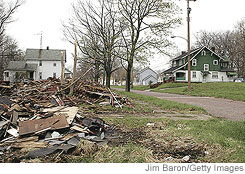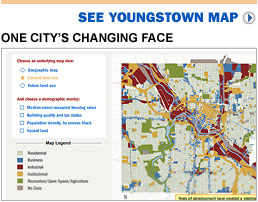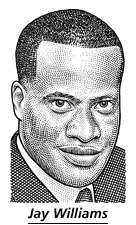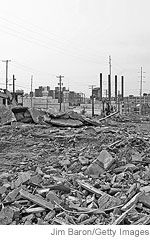This is a must read for anyone contemplating the decline and "hollowing out" of Buffalo, NY. Mayor Jay Williams is no stranger to fixBuffalo. Featured a recent Smart City interview with him - Learning from Youngstown.


The approach is controversial. Encouraging and accepting the hollowing out of neighborhoods will, by default and design, hit Youngstown's poor and minority residents the hardest. About 45% of Youngstown's residents are black, another 5% Hispanic, and the blight is heavily concentrated in minority neighborhoods, which are slated for the biggest makeovers.
Youngstown, which has lost half its population since the 1950s, says it needs a radically different approach to halt decay. It's pointless to try to revive certain neighborhoods, the city's leaders argue, since the exodus of residents often makes those areas unpleasant and dangerous places to live, leading to further decline. "The concept of trying to grow out of economic malaise is just not realistic for us," says Mayor Jay Williams, 35 years old. One of his first official acts after being elected in 2005 was to apply surplus money to demolition in the city.
Very cool interactive maps available in the on-line version of Shrink to Fit. Podcast, too explaining the mayor's approach and rational for changing the way we think about decline.
"It's un-American. It seems like you're doing something wrong if you're not growing," says Hunter Morrison, director of the Center for Urban and Regional Studies at Youngstown State University, who worked with the city to come up with its strategy. But he says the idea is "not really about growth or shrinkage, it's about managing change."
Imagine...cutting out large chunks of the urban landscape here in Buffalo - neighborhoods that are no longer thriving, that are dead. Imagine removing sidewalks, schools, streets and sewers. Does Buffalo have the intestinal fortitude to make the sort of changes necessary to right-size the City?
__________________________________________________________________________See also - Getting Smarter about Decline...includes links to Blueprint Buffalo. Interested in issues involving "brownfield reclamation" see Learning from Others. Make sure to check out LISC - Buffalo and National Vacant Properties Campaign for addtional information regarding issues and major public policy initiatives involving abandondment, vacancy and the management of decline.
Artspace • BAVPA • Tour d'Neglect - 2007 • Woodlawn Row Houses • faq • my flickr
the creativity exchange • CEOs for Cities



5 comments:
David:
Thanks for closely following Youngstown's leadership on "smart decline".
Fortunately Bflo is slowly catching on. On Wednesday Commissioner of Permits & Inspections Rich Tobe summarized on Michele Johnson's radio show that the City has allocated $14 million for demolitions in the coming fiscal year.
LISTEN AT: www.wnymedia.net/index.php?option...d=16&Itemid=46
The city has $6 million for demolitions in the new budget beginning July 1 & is awaiting $8 million more from NYS. Tobe also expressed stong support for deconstruction & its potential to create neighborhood jobs, while reducing landfill.
Tobe reviewed some shocking statistics:
a. 40% of fire calls are to vacant structures
b. The city did 144 emergency demo’s last year at a cost of $2.4 million.
c. There are over 22,000 housing vacancies (NOTE: 2000 Census, likely 25,000 today?) in 10,000 vacant structures.
d. There are 7 vacant units for every 100 persons in Bflo.
e. It costs the city $20,000 to maintain a city-owned house over 5 years
f. The city plans to demolish 1,000 structures annually for a decade.
It was also good to hear from Tobe that there are clearer criteria & priorities for determining order of demo’s:
1. Emergency demo of dangerous or fire-destroyed house.
2. Bad houses by public institution (school, agency, etc)
3. Good block with single bad house
4. Proposed site for new housing
5. Eventual landbanking (badly needed, but Tobe not promising it immediately)
Tobe also committed to removing any house from the demo list for 6 months if interested parties want to explore their capacity to rehab it.
It is good to see Buffalo Re-Use up & running on the threshold of a massive demolition initiative by the City.
This hand demolition initiative is long overdue.
About 10 years ago I was required to demolish 452 Sweet, a $2,000 HUD-foreclosed house, when the rent-to-own 'buyer' & block-club secretary failed to make promised repairs or repay my rehab loan to her. I contracted with an alleged environmentally-friendly demolition contractor from Lackawanna, who turned out to be a scammer. Having been convicted of "failure to evict" by Housing Court Judge Michael Broderick, I contracted for a $6,000 demolition with an ES contractor. It was the 26th demolition on the block of devastated Sweet Avenue (near Walden Ave).
Dick Kern, (in Mpls)
COPY: www.buffalorising.com/story/buffa...ompletes_first
Buffalo ReUse Completes First Deconstruction
The final debris were cleared away last night from 26 Lombard St., where just days ago another house stood neglected in its East Side neighborhood. But, thanks to Buffalo’s newest non-profit, this house fell by deconstruction, not total demolition. So instead of wasting away in a landfill, many of the home’s remains will find new life in other corners of the city. And the lot where the house once stood will likely become a garden for its very happy, horticulturally-blessed neighbor.
Volunteers with Buffalo Re-Use took down the house, their first deconstruction attempt, in just four days. With 6-8 volunteers working each day, through the rain and mud, the group completely dismantled the building to ground level and successfully recycled 1,000s of pounds of material. All the salvaged material will be on sale at their Ellicott Street warehouse this Sunday.
The crew worked under the supervision of national deconstruction consultant David Bennink, of Re-Use Consulting, who has been guiding the founding members along their journey. He has clients from coast-to-coast who are trying to change the way societies look at their buildings and their resources.
Michael Gainer, executive director of Buffalo Re-Use, brought Bennink in to teach the new group techniques for deconstruction, which will continue to evolve with each new project.
"Now we know we can do it,” Gainer said upon completion Monday. “It's challenging but meaningful work. I think we're really ready to put this idea into motion and fulfill our mission."
The very triumphant, yet very tired, group will set out to dismantle their second home, on Wasson Street, on May 18.
Buffalo ReUse’s warehouse at 459 Ellicott St. will be open from noon to 3 p.m. this Sunday, May 6. Check here for a list of their salvaged inventory.
Interestingly, Youngstown has not yet found effective ways to discourage flippin of their massive surplus of houses. On eBay currently Youngstown has about 15 flips for sale, while Bflo has merely one.
SEE eBay: www.realestate.listings.ebay.com/Residential_W0QQfclZ3QQfromZR11QQsacatZ12605QQsocmdZListingItemList
Dick Kern (in Mpls)
I have been following fixBuffalo for at least a year. I thought the idea here was to save Buffalo from demolition, not to demolish it. I am still disappointed that homes of several of my ancestors have been destroyed, many of which for which I have no picture. I have collected hundreds of pictures of old Buffalo houses, many from this site. I wish I had a picture of 73 Brown St., 426 Monroe, and 824 Genessee. I hope people will photodocument every house left on the Old East Side before it is gone... centans
If you ever want a tour of Youngstown, let me know!
shoutyoungstown.blogspot.com
Janko...
Thanks...thinking of a short road trip later this summer...
Everyone...
Visit Janko's Blog... Awesome 'sphere in Youngstown...
I strongly disagree with Mayor Brown's, "right sizing", and this endless use of cost projections that simply are not true. Do the math. 2.4 Million divided by 144, is almost $17,000 each. It only cost $17,000 to demo a Buffalo house in the minds of Brown and his fellows as they are willing to pay it. No place in America does a demo reach this figure. When you go to the Buffalo and try to purchase one of these houses the Real-estate Department cannot tell you a listing price, they do not have sale prices for them. They cannot even tell you the asking price for a empty lot. The reason the Department charged with selling the homes is not selling them, I was told by a department sales person while trying to buy one, is the governments own appraisor don't supply the information to the real-estate sale office. People have gone to the city with cash in hand to purchase the house next door, on the demo list, to save it from the demo list, and they have been told they cannot because the real-estate sale office cannot set a sale sprice for lack of an appraisal. I challenge anybody to investigate, try it. Buffalo already has its "Land Bank" but Tobi and Mayor Brown won't admit it. Stop the "shocking statistics", put the houses up for cash sale and let the market work for first time home buyers. I live in the heart of Emerson and it does not cost $20,000 a year to allow a house to decay.
James Kistner / Grad. Student
University at Buffalo
School of Architecture
Department of Urban Planning
Post a Comment